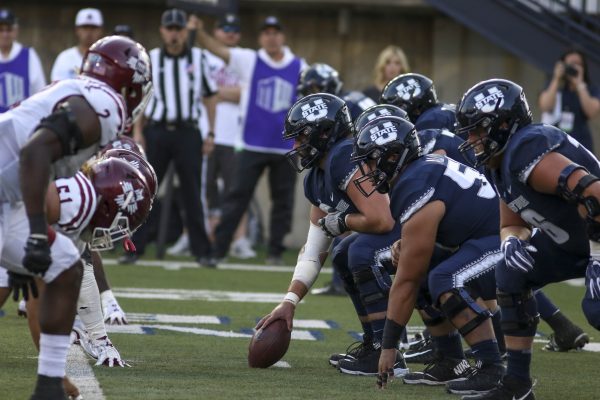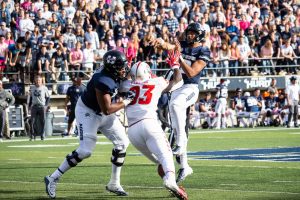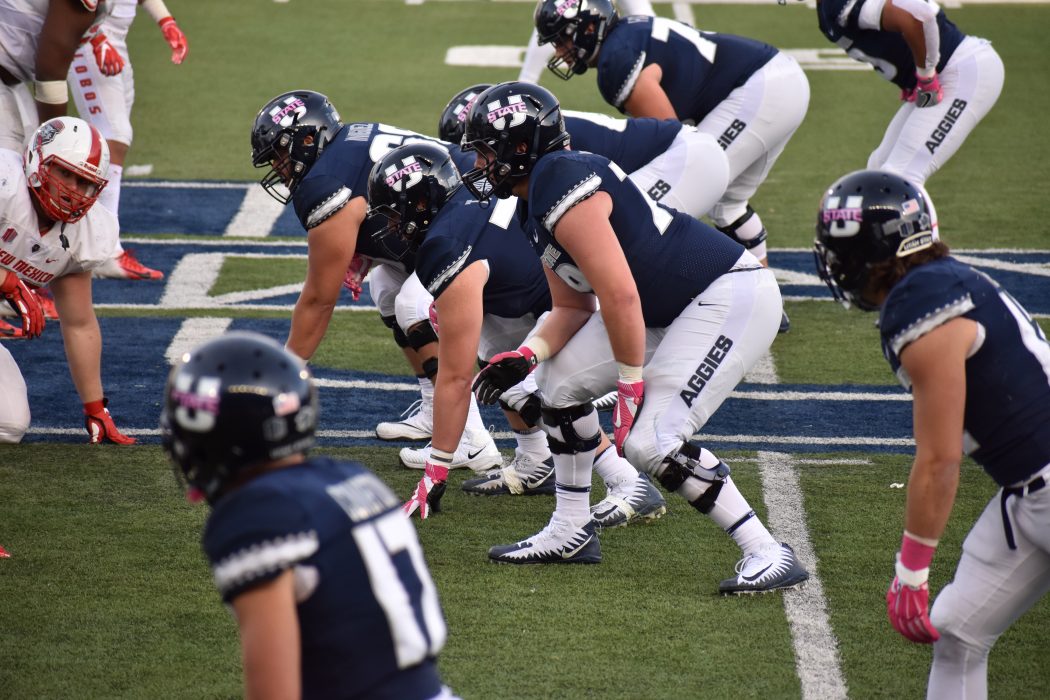USU football’s new offensive line talented but unproven
Of all the cogs in the destructive machine that was Utah State’s offense in 2018, one that took its 13-game schedule and made it a mere plaything, the offensive line was arguably the largest in terms of contribution to the whole.
All of the record-breaking raw production, efficiency and overall winning that said machine created was propped up on the backs of the 300-pound hogs in the trenches. It’s a stereotypical thing to say that the offensive line is key to any success, but the usual utterance of praise for the o-line is usually precipitated and/or followed by long drawn out discussions of the quarterback, receivers, running backs, etc and their statistical achievements.
Last season, the offensive line protected Jordan Love with scary efficiency. You can count on your fingers and thumbs the mere 10 sacks allowed by Utah State in a 13-game span (fourth in the nation behind such pass-happy teams as Army and Air Force). In other words, Love’s back hit the turf less than once per game while dropping back to pass 30-plus times on average. To be fair, a lot of that came from quick throws, eliminating many sack opportunities, but the o-line still gets plenty of credit.
With all of the upheaval the Aggies faced during the offseason — mainly the departures of key players and coaches — the questions regarding the 2019 iteration of the O-line remain the most unanswered, yet are among the most important queries that need answering.
Just one full-time starter from 2018 returns to the roster this season: Alfred Edwards, the left tackle. The rest, with rare exception, are a mixture of unproven players and young, though promising, freshman. Of the 15 linemen listed on the roster, only three are upperclassmen (and only one of those has meaningful experience).
Naturally, with this gaping hole in returning offensive contribution, spring and fall camp contained a fair amount of competition for the four starting spots. And now with week one finally upon us, the team released a depth chart announcing the victor of the five (kind of) separate positional battles.
Edwards, the only incumbent, predictably held on to his left tackle job. Andy Koch beat out the contenders for the opposite tackle spot with Ty and Karter Shaw earning the start left and right guard, respectively. Those three are the highly inexperienced of the crew, having combined for 168 total snaps in 2018.

Utah State’s offensive line lines up against New Mexico State in USU’s 60-13 win on Sept. 8, 2018 – Tim Carpenter
The last starting job went to the most experienced man on the roster (plot twist, it’s not Edwards and his 11 starts) in junior Demytrick Ali’ifua. The new starting center has 779 total offensive snaps under his belt between his redshirt freshman and sophomore seasons (Edwards has “just” 662). Ali’ifua has played in all 26 games of the past two years and has four starts to boot.
So three of the linemen have less than a single game’s worth of snaps each and two have one season (or the equivalent) under their belts. That’s very inexperienced. First-year offensive coordinator Mike Sanford Jr and his staff were obviously quite aware of the deficiency of experience when they took their respective jobs.
“We saw the numbers, returning starts, the amount of freshman and sophomores that we were most likely going to have to depend upon,” Sanford said.
Unfazed, obviously since they took the job, Sanford and company were apparently rewarded for their risk when they saw them in spring practices.
“I was really encouraged when we actually had the chance to watch them work out and then very encouraged when I saw their process of getting baptized under fire during spring ball,” Sanford said. “The thing that stuck out to me with those guys was just that they have a spirit of nastiness to them…they love to be around each other. They’re the kind of offensive line that I think is going to be really exciting to be around and I honestly can’t wait to be around them for three or four years.”
In summary of all this, Sanford made a clear statement in saying that he could see “the beginnings of an elite offensive line group for three, four years to come.” High praise.

Alfred Edwards blocks for Aggies’ QB Jordan Love against New Mexico in USU’s 61-19 win over the Lobos on Oct. 27, 2018.
Edwards, the last connection to the dominant group of five from last year, said this group is certainly younger but that “we have a lot of talent” and that “everybody has something to prove so I think it’s going to be a fun year for everybody.” Along with that, Edwards favorably compared the two quintet’s athletic abilities.
“Last year we were pretty athletic, that’s what we leaned on in our tempo offense,” he said. “Coming back this year, we’re even more athletic and I feel like (we’re) a little bit stronger. I just hope we can take that to the field and dominate.”
Sanford obviously believes in the talent of this group and an elite O-line down the road is great, the dream development path for just about any coach. But the Aggies will need superior play in the trenches in less than one week. Love likely won’t appreciate hearing his O-line teammates say “don’t worry, we’ll be great in a year or two” while the former is lying on his backside with a 315-pound defensive end crushing his windpipe.
This is where conjecture is at its highest. For all the positive words that inevitably flow from spring, summer and fall camps/practices/workouts, in the end, Friday’s matchup with Wake Forest and the rest of the 12 games will ultimately prove just how true all the early praise is. Not only that, the performance of the o-line will dictate the potential of the offense in 2019, just as it did in 2018.


Jason, you do a great job with your articles — real analysis and well written. Thanks, Todd